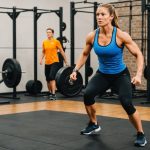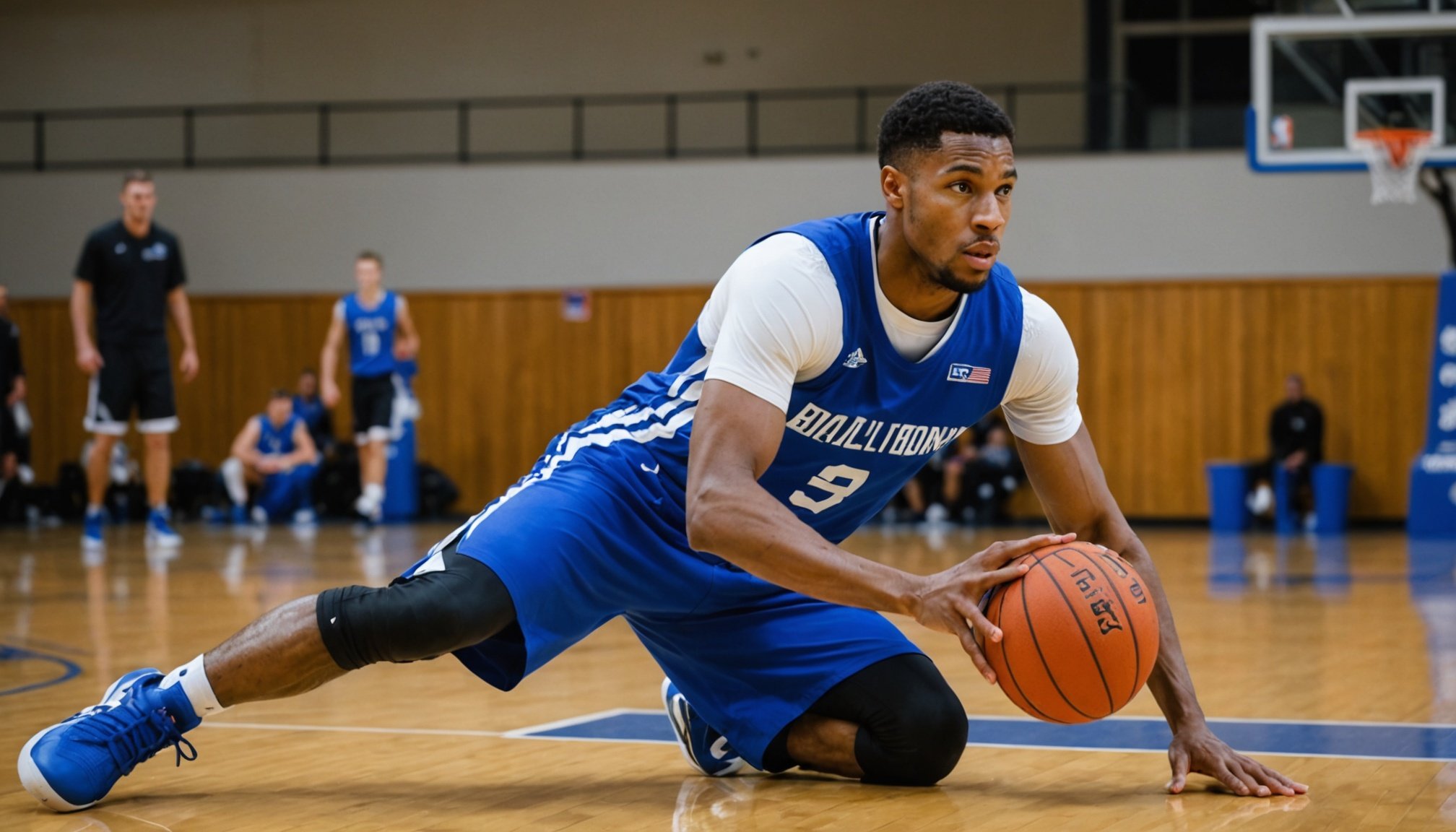Transform Your Skills: Top Agility Drills Every UK Basketball Player Should Master
Why Agility Drills are Crucial for Basketball Players
In the fast-paced and dynamic world of basketball, agility is more than just a desirable trait; it’s a necessity. Agility drills are designed to enhance your speed, quickness, and overall court performance. Here’s why these drills should be a cornerstone of your basketball training:
- Enhanced Performance: Agility drills improve your ability to change direction quickly, which is essential for dribbling, defensive maneuvers, and rapid movements around the court. This enhances your overall game performance and makes you a more formidable player[1][2].
- Injury Prevention: Strong ankles and well-conditioned muscles reduce the risk of injuries, particularly those related to sudden stops, jumps, and changes in direction. This is crucial for maintaining your health and ensuring you can play at your best throughout the season[2].
- Confidence Boost: When you feel agile and quick on the court, you gain confidence in your abilities. This confidence translates into more aggressive and effective play, whether you’re on offense or defense.
Warm-Up and Preparation
Before diving into agility drills, it’s essential to prepare your body with a thorough warm-up. Here’s a step-by-step guide to get you ready:
In the same genre : Elevate your game: key hydration tips for uk basketball athletes”
Dynamic Stretches
- Arm Circles: Hold your arms straight out to the sides and make small circles with your hands for 30 seconds in each direction.
- High Knees: Run in place, bringing one knee up towards your chest while keeping the other foot on the ground. Alternate legs for 30 seconds.
- Walking Lunges: Perform walking lunges, taking 10 steps with each leg. This helps loosen your hips and legs.
- Jumping Jacks: Do jumping jacks for 1 minute to get your heart rate up and warm your muscles[1].
Essential Agility Drills for Basketball Players
Here are some of the top agility drills that every UK basketball player should master:
Ladder Drills
Ladder drills are excellent for improving foot speed, agility, and coordination.
Also to see : Enhancing court awareness: top strategies for uk basketball players to elevate spatial vision
- Lateral Shuffles: Place the ladder on the ground and perform lateral shuffles through the rungs, keeping your feet inside the ladder.
- Reps/Sets: 3 sets of 10 reps.
- Why It Works: Enhances lateral movement, crucial for defensive plays and quick changes in direction.
- High Knees Through Ladder: Run through the ladder, lifting your knees high.
- Reps/Sets: 3 sets of 10 reps.
- Why It Works: Improves speed and agility while strengthening your core and leg muscles[1].
Cone Drills
Cone drills are versatile and can be tailored to various aspects of agility training.
- Weave Through Cones: Set up cones in a zigzag pattern. Weave through the cones using different footwork patterns (e.g., inside-outside, crossovers).
- Reps/Sets: 3 sets of 10 reps.
- Why It Works: Enhances speed, agility, and the ability to change direction quickly.
- Cone Box Drill: Set up cones in a box shape. Start at one corner and perform a series of movements (e.g., forward, backward, lateral shuffles) to reach the opposite corner.
- Reps/Sets: 3 sets of 10 reps.
- Why It Works: Improves overall agility and reaction time[1].
Plyometric Exercises
Plyometric exercises are key for building explosive power.
- Box Jumps: Stand in front of a box or bench. Jump up onto the box and immediately step back down to the starting position.
- Reps/Sets: 3 sets of 10 reps.
- Why It Works: Enhances explosive power, crucial for jumping and quick movements.
- Depth Jumps: Stand on a box or bench. Jump down to the ground and immediately jump up as high as possible.
- Reps/Sets: 3 sets of 10 reps.
- Why It Works: Conditions your muscles for high-impact landings and improves overall power[2].
Ankle Specific Strength and Conditioning
Strong and resilient ankles are often overlooked but are vital for basketball players.
Resistance Band Exercises
- Ankle Inversions and Eversions: Attach a resistance band to a stable object and perform inward and outward ankle movements.
- Reps/Sets: 3 sets of 10 reps.
- Why It Works: Strengthens the muscles around the ankle, reducing the risk of sprains and strains.
- Dorsiflexion and Plantarflexion: Flex your foot up and down against the resistance band.
- Reps/Sets: 3 sets of 10 reps.
- Why It Works: Strengthens the front and back of the ankle, improving stability and balance[2].
Balance and Stability Drills
- Single-Leg Balance: Stand on one foot and challenge your balance by closing your eyes or using an unstable surface like a balance board.
- Reps/Sets: Hold for 30 seconds per leg.
- Why It Works: Improves balance and stability, reducing the risk of ankle injuries.
- Proprioceptive Exercises: Use balance discs or wobble boards to improve your body’s awareness of its position in space.
- Reps/Sets: Perform for 30 seconds per leg.
- Why It Works: Enhances proprioception, helping prevent ankle rolling and other injuries[2].
Cool Down and Recovery
After a rigorous training session, it’s crucial to cool down and recover properly.
Static Stretches
- Hamstring Stretch: Stand with your feet shoulder-width apart, then bend forward at the hips to stretch your hamstrings. Hold for 20-30 seconds.
- Quad Stretch: Stand with one hand against a wall for balance. Bend one knee, keeping your foot behind you, to stretch your quadriceps. Hold for 20-30 seconds per leg.
- Child’s Pose: Kneel on the ground and sit back onto your heels. Stretch your arms out in front of you and lower your forehead to the ground. Hold for 20-30 seconds.
- Shoulder Stretch: Hold your arm straight out to the side at shoulder height. Use your other hand to pull your hand toward your shoulder blade. Hold for 20-30 seconds per arm[1].
Active Recovery Techniques
Active recovery is essential for maintaining your physical health and readiness for the next game.
Low-Intensity Exercises
- Walking: A gentle walk can help increase blood flow and reduce muscle soreness.
- Yoga: Focuses on flexibility and can help in reducing muscle tension.
- Swimming: A low-impact exercise that helps in maintaining cardiovascular fitness without putting excessive strain on your muscles.
- Jogging: A light jog can help in keeping your muscles flexible and ready for the next intense session[3].
Foam Rolling and Massage
- Foam Rolling: Use a foam roller to target specific muscle groups, improving circulation and reducing pain.
- Massage Tools: Utilize tools like massage sticks, massage guns, or tennis balls to target areas of tension and improve mobility[3].
Ice Baths
- Cold Water Therapy: Take an ice bath to reduce inflammation and improve recovery by changing blood and fluid flow in your body.
- Duration: 10-15 minutes.
- Why It Works: Helps in getting rid of metabolic waste and reducing muscle soreness[3].
Practical Insights and Actionable Advice
Here are some practical tips to integrate these drills into your training routine effectively:
Create a Balanced Training Plan
| Training Component | Description | Frequency |
|---|---|---|
| Strength Training | Focus on upper body, lower body, and core strength using exercises like bicep curls, hamstring curls, and planks. | 2-3 times a week |
| Agility Drills | Incorporate ladder drills, cone drills, and plyometric exercises to improve speed and agility. | 2-3 times a week |
| Ankle Conditioning | Include resistance band exercises, balance drills, and proprioceptive exercises to strengthen your ankles. | 2 times a week |
| Active Recovery | Engage in low-intensity exercises, foam rolling, and ice baths to aid in recovery. | Daily/Every other day |
Stay Hydrated and Properly Fueled
- Hydration: Ensure you drink plenty of water and electrolyte-rich fluids to maintain optimal hydration levels.
- Nutrition: Eat balanced meals that include proteins, carbohydrates, and healthy fats to support muscle recovery and energy replenishment[3].
Quotes from Experts
- “Strong ankles are better equipped to withstand awkward landings, sudden direction changes, and collisions with other players. This is why ankle strength and conditioning are so crucial for basketball players,” says a sports physiotherapist from Whitehouse Clinic[2].
- “Active recovery is a workout that involves low-intensity exercises to help your muscles recover after intense physical activity. This is a great way to increase blood flow, reduce lactic acid buildup in muscles, and keep muscles flexible,” advises Kendra Franck from Dr. Dish Basketball[3].
Transforming your basketball skills requires a holistic approach that includes strength training, agility drills, ankle conditioning, and active recovery techniques. By incorporating these elements into your training routine, you can significantly improve your performance on the court, reduce the risk of injuries, and become a more confident and effective player.
Remember, it’s not just about how high you can jump or how fast you can run; it’s also about how well you can protect and rely on your ankles, how efficiently you can recover, and how balanced your training plan is. With dedication and the right techniques, you can elevate your game and become a star player in no time.











